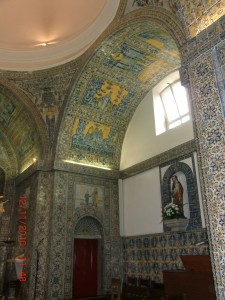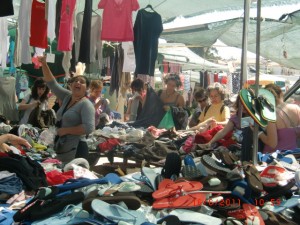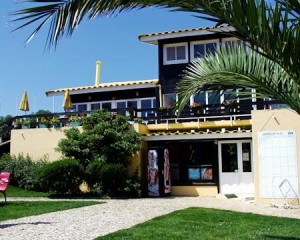Carcavelos is divided by the Cais do Sodre to Cascais coastal railway line. North of the line is the charming, traditional, quiet, older part of town. It has a small commercial centre, an outdoor market, shops, restaurants/cafes, a church, an ice cream parlour and a cinema where newly released films are shown in English/French with Portuguese subtitles.
The church’s panels of tiles are famous and an absolute must see. They proved such an attraction that the famous Portuguese writer, Jose Saramago, made a special detour from Lisbon to see them when he undertook a tour of his homeland in 1979. Postcards and reproductions as well as some original tiles and hand painted gifts can be bought from the nearby shop, Ceramica Artistica de Carcavelos.
South of the railway line is the extensive, popular, well maintained beach resort, visited mainly by Portuguese people and surfers but becoming better known to other tourists. It’s used for sunbathing, surfing and paddle surfing (and an increasing number of associated schools run courses for children and adults, hire wet suits and film students as they learn), body boarding, volleyball, swimming and fishing.
Beds/umbrellas are available for approx. 13€ day, 9€ for half a day (in 2016). The average sea water temperature in summer is 18 ºC.
Local attractions include:
The ‘International Fair of Carcavelos‘ -the Thursday market is famous for cheap’ish ‘brand’ clothes, shoes, bags, jewelry, linen, towels, DVD’s, hardware, furniture etc. Bargaining is acceptable but prices are low.
The Riviera centre with a well stocked supermarket, shops and an hotel with outdoor pools and a small indoor spa/pool.
- Beach bars/cafes/restaurants on the esplanade and close to the apartment, as well as in the older part of town
- A 7km+ coastal walkway from Carcavelos past Oeiras Marina to São João dos Maias fort at the end of the Santo Amaro beach
- A sea water pool, Piscina Oceanica, en route (?€11.10/day, €8.80/half a day for adults) and with special children, senior and family rates.
The Carcavelos Tennis club has 11 courts (three indoor courts) and welcomes visitors.
Restaurants
- Atlantico is a great if expensive fish restaurant close to the apartment
- There are a number of other less expensive restaurants close-by
- Taverna do Rogerio is nearby in Rebelva on the there side of the railway tracks. Probably a 30min walk or a short taxi ride away. Well worth the effort. There’s also Restaurant Traga Luz which serves good, basic Alentejan food
- Tea/scones are popular! There’s a great Salão de Chá in the square.
Swimming Pools
Abla Guest House is closeby and has a pool that is open to non-residents (and affordable accommodation). Bring your own drinks and snacks. The Guest House is part of a charitable institution which works to benefit the local community.
There are two large, public, sea water pools on the lovely sea-front walk. And there are two more between the nearby seaside resorts of Estoril and Cascias.
A (contested) major new development is planned in the empty section of Quinta dos Ingleses (close to St Julian’s school). The plan is to build 900 homes, a hotel, commercial spaces, a large urban park and more. Opposers consider it an attack on the environment and people’s quality of life. They want it developed as a park with lots of trees.
Interestingly, this area once housed the Portuguese HQ of Atlantic Cable & Undersea Communications. The first cable to Cornwall was from Carcavelos in 1870 and to Horta in the Azores in 1893. Links were also made to other stations in Spain, Madeira, Cape Town etc.
The old station house still stands, covered in graffiti. The surrounding empty land is currently used as a temporary car park for beach goers. Old photos of Carcavelos, including one of ‘Casa do Cabo Submarino’ can be viewed in this useful and informative website: carcavelos.com
Development plans for Carcavelos & Parede are discussed here (in Portuguese). The future looks bright for the area.



